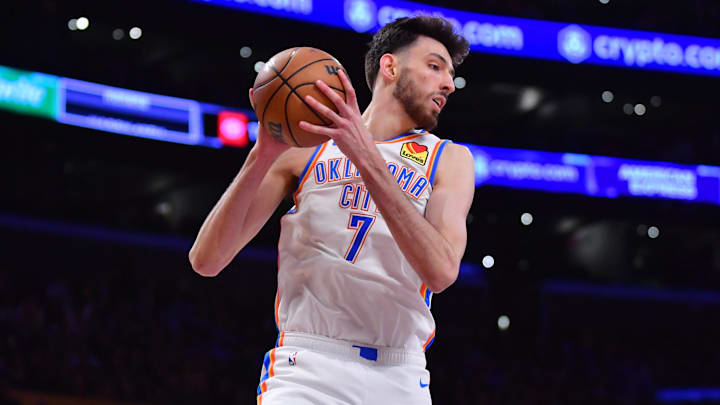Using Four Factors to Explain Thunder Proficiency, Part Three: Rebounding

In this story:
Part One in this series details how a significant chunk of the Thunder's success last season came from two-way scoring efficiency. They ranked third in effective field goal percentage (57.3%) and fourth in effective field goal percentage allowed (53.0%), taking advantage of offensive possessions that resulted in field goal attempts, and vice versa.
Part Two shows why two-way turnovers are Oklahoma City's greatest team strength. They recorded the fifth-lowest turnover percentage (12.5%) and highest opponent turnover percentage (15.5%) in the league last year, an output that remained consistent from the prior season.
The 2023-24 Thunder were synonymous with efficiency on both ends of the court. However, securing more total possessions matters along with making the most of those possessions, and the team's biggest statistical weakness was giving up more offensive rebounds than they grabbed.
Offensive rebounds are instrumental in scoring more points because they essentially offset missed shots. Their cumulative impact has arguably decreased since the NBA changed the ensuing shot clock from 24 seconds to 14 seconds, but those seconds are still more than enough to generate a quality look. The offensive rebound percentage formula is offensive rebounds / (offensive rebounds + opponent defensive rebounds).
Oklahoma City had the third-lowest offensive rebound percentage (25.0%) and fourth-highest opponent offensive rebound percentage (30.2%) last season. This discrepancy meant that Thunder opponents generated about five extra opportunities per 100 possessions, as offensive rebounds do not end a possession.

The team's lackluster defensive rebounding carried over from the 2022-23 season when they allowed a 30.7% offensive rebound percentage, but their own offensive rebounding decreased by about 4%.
Most returning Thunder players had offensive rebound percentages below 5%, except for Chet Holmgren, Aaron Wiggins and Kenrich Williams. Holmgren is an unsurprising inclusion as the starting center, while Wiggins and Williams frequently hang out in the dunker's spot to anticipate efficient interior shot attempts.
Holmgren's 6.2% offensive rebound percentage was still far below the most prolific offensive rebounders in the league, as that percentage did not even make the top 150 players who logged at least 15 minutes per game. However, last season's leaders, including Andre Drummond, Mitchell Robinson and Day'Ron Sharpe, all fit the traditional big mold by playing right next to the rim. Holmgren naturally does not grab as many offensive boards because he spaces the floor within the Thunder offense.

Oklahoma City made their biggest free agency signing in franchise history this offseason, giving Isaiah Hartenstein a three-year, $87 million deal with a team option. Among other factors, Hartenstein's offensive rebounding is what makes his potential fit with the Thunder so encouraging. The 2023-24 Knicks led all teams with a 33.3% offensive rebound percentage, and Hartenstein's 14.4% offensive rebound percentage ranked second among all qualifiers behind Hawks center Clint Capela.
In the most recent Thunder vs. Knicks game on March 31, 2024, Hartenstein grabbed six offensive rebounds that all led to immediate second-chance points. His putback dunk over Holmgren set the tone for the rest of the night.
Hartenstein joining the Thunder also benefits his teammates' rebounding. Holmgren recorded an 8.3% offensive rebound percentage in 92 minutes next to fellow big man Jaylin Williams, as opposed to a 5.6% offensive rebound percentage in his other 2,321 minutes. Mark Daigneault employing the new double-big lineup should lead to more frequent offensive rebounds.
The Thunder were one of the league's worst rebounding teams last season, but signing Hartenstein this summer was the ideal choice to help remedy those problems.
Want to join the discussion? Like Thunder on SI on Facebook and follow us on Twitter to stay up to date on all the latest Thunder news. You can also meet the team behind the coverage.
